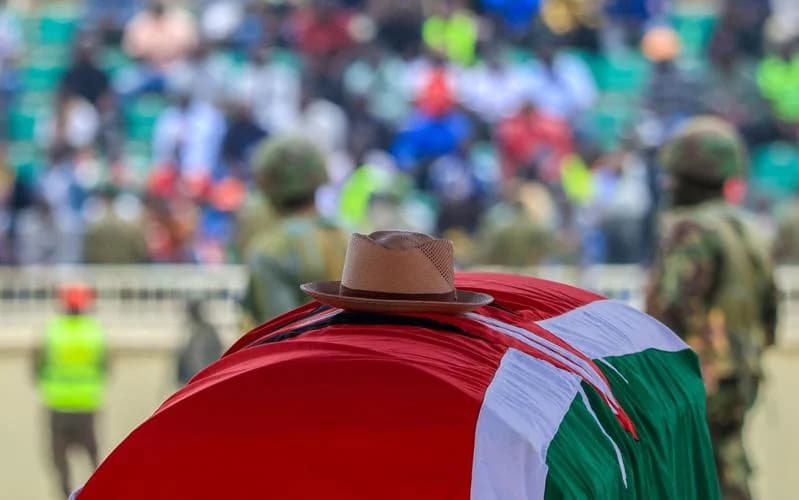Loading News Article...
We're loading the full news article for you. This includes the article content, images, author information, and related articles.
We're loading the full news article for you. This includes the article content, images, author information, and related articles.
The recent passing of veteran opposition leader Raila Odinga leaves a significant void in Kenya's political arena, prompting questions about the future direction and leadership of the democratic opposition ahead of the 2027 general elections.

The death of veteran Kenyan opposition leader Raila Odinga on Wednesday, October 15, 2025, at the age of 80 in Kochi, India, has profoundly impacted the country's political landscape. Odinga, who had a cardiac arrest, was a dominant force in Kenyan politics, having run for the presidency five times between 1997 and 2022. His passing creates a significant leadership vacuum within the democratic opposition as Kenya looks towards the 2027 general elections.
President William Ruto, in an address to the nation, described Odinga as "a once-in-a-generation leader," "a giant of democracy," and "a tireless warrior of good governance," declaring seven national days of mourning and announcing a state funeral.
Kenya has a rich history of political activism and protest, dating back to the early 20th century when communities resisted colonial policies. The struggle for multi-party democracy intensified in the late 20th century, with figures like Odinga playing a crucial role in challenging single-party rule and advocating for reforms. The 2010 Constitution enshrined the right to peaceful assembly, demonstration, picketing, and petitioning public authorities, a fundamental right that was often suppressed in previous regimes.
Despite constitutional protections, the right to peaceful assembly has not always been fully respected, particularly in protests against the government. The Public Order Act requires organizers to notify the police between three and fourteen days in advance of a public assembly. However, critics argue this has sometimes been used to restrict legitimate protests.
Kenya has experienced a wave of youth-led protests in recent years, notably against the Finance Bill 2024 and in June 2025 following the death of blogger Albert Omondi Ojwang in police custody. These demonstrations, largely mobilised through social media, highlighted public discontent over rising living costs, government corruption, and police brutality.
The government's response to these protests has varied. While President Ruto withdrew the Finance Bill 2024 after widespread unrest, police responses to demonstrations have often involved tear gas, water cannons, and, in some instances, live ammunition, leading to casualties. Civil society organisations have condemned the excessive use of force and denied government allegations of funding unlawful behaviour, asserting their role in providing legal aid and medical assistance to affected individuals.
Kenyan political parties, often organised around ethnic kingpins, have historically been unstable, with new ruling parties emerging in almost every election cycle since 2002. Major parties include the United Democratic Alliance (UDA), Orange Democratic Movement (ODM), Jubilee Party, and Wiper Democratic Movement–Kenya. The opposition plays a crucial role in championing minority positions, negotiating with the majority party, and providing checks and balances on the government.
Civil society organisations (CSOs) are vital in safeguarding democratic values, amplifying community voices, promoting transparency, and upholding human rights. They have been instrumental in advocating for public finance management accountability and protecting freedom of expression and assembly.
The immediate future of Kenya's democratic opposition without Raila Odinga at its helm remains a key question. While Odinga's political life was marked by a persistent pursuit of democratic principles, his movements sometimes blurred into personality, and his coalitions carried contradictions. His decision to work with President Ruto in March 2025, which saw his Azimio la Umoja party involved in policymaking and its members appointed to the cabinet, had already divided some of his loyalists.
The youth-led protests of 2024 and 2025 demonstrated a powerful, digitally savvy generation capable of mobilising without traditional political affiliations. This shift suggests a potential for new forms of opposition leadership and organisation to emerge, focused on issues of governance, accountability, and economic hardship. The upcoming 2027 elections will be a critical test for how the opposition redefines itself and navigates the post-Odinga era.
Keep the conversation in one place—threads here stay linked to the story and in the forums.
Other hot threads
E-sports and Gaming Community in Kenya
Active 6 months ago
Popular Recreational Activities Across Counties
Active 6 months ago
The Role of Technology in Modern Agriculture (AgriTech)
Active 6 months ago
Investing in Youth Sports Development Programs
Active 6 months ago